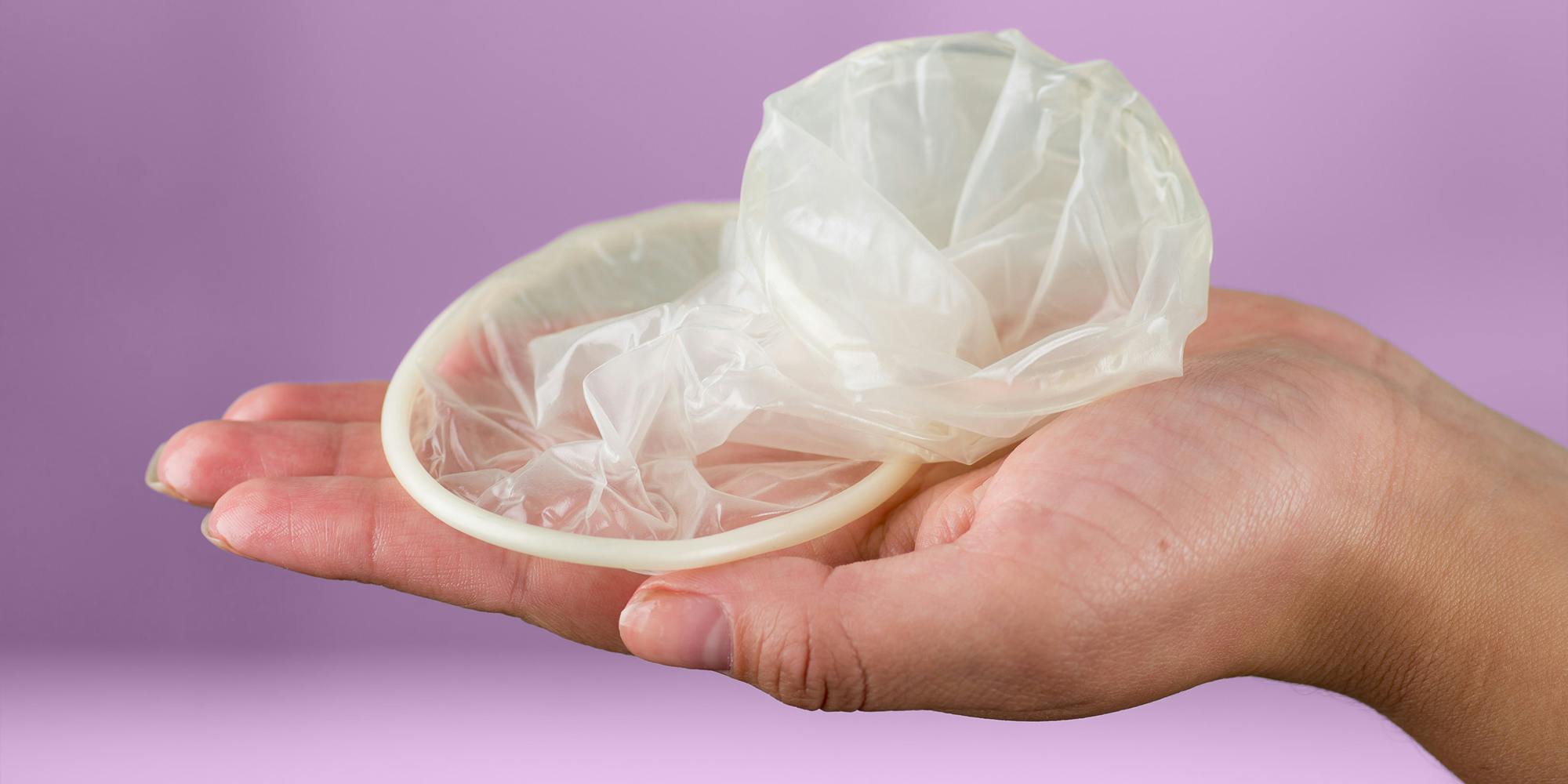
When we all think of condoms, we all have an image in mind: the regular old condom that covers the penis, right? It is just known as the condom, not the “male condom” or “external condom.” Just a condom. It is as if other condoms don’t exist.
But there are other methods of barrier protection than the traditional latex condom. Here’s what you need to know about the internal condoms.
Demystifying the internal (formerly female) condom.
The internal condom, formerly known as the female condom, is just as effective and is used at a significantly lower rate. It is a versatile method of contraception and protection against sexually transmitted diseases (STDs) and sexually transmitted infections (STIs). The name changed not only due to the unnecessary gendering of the condom but also because it can be used for anal sex and as a barrier method for oral sex.
So what is an internal condom?
An internal condom is a soft, pre-lubricated plastic pouch that can be inserted into the vagina or anus. Once inserted into the vagina, for example, the excess of the pouch is used to cover some parts of the vulva. It is an excellent alternative for people allergic to latex as it uses a plastic nitrite material. This material allows you to use any type of lubricant without damaging the condom or its efficacy.
Dr. Robyn Johnson, a medical practitioner, told Cashmere that the internal condom has two flexible rings, “One on each end: an inner ring that is inserted into the vagina and the outer ring which creates a cover outside the vagina and vulva.” This barrier does more than protect against pregnancy by inhibiting semen from reaching the uterus. It also protects people with vaginas from STIs which may be transmitted via skin-to-skin contact, like herpes or HPV, by creating a barrier externally.
The rings found within the internal condom help to keep the condom in the vagina to avoid any potential mishaps. Dr. Johnson shares that the internal condom is up to 95% effective against pregnancy, STDs, and STIs. However, she cautions that “no human is perfect. Efficacy could fall to 79% due to human error.” It is essential to read the instructions carefully and insert the internal condom correctly to reap its full benefits.
How to use an internal condom
The internal condom can be inserted by lying down, squatting, or putting one foot on a chair or even on the closed toilet seat. If you insert it vaginally, squeezing the inner small ring between your fingers and leading it into your vagina as you would a tampon is most effective. Once it is in your vagina, use your finger to insert the condom as deep as you can, preferably reaching the cervix.
If you are inserting the condom into your anus, start by removing the inner ring first, after which you can simply push it further using your finger. Once you’ve effectively inserted the condom, ensure the outer ring hangs out of the vagina or anus by an inch. Although the internal condom is pre-lubricated, you can add more if needed – there is no such thing as too much lubricant! To remove, twist the outer ring in case of any bodily fluids collected inside, gently pull it out, and discard.
Benefits of the internal condom
Surprisingly, internal condoms can enhance sexual pleasure. While the condom is inserted, the covering over the vulva can be rubbed to stimulate the clitoris. During penetration, the external ring and outer part of the condom may rub or create friction against the clitoris. The intensity of the rubbing or friction can be controlled by the thrusting speed, motion, and depth into the vagina.
This combination of stimulation both internally in the vagina and externally on the vulva and clitoris can be the catalyst for an intense orgasm that is either clitoral, vaginal, or both if you’re lucky.
Who uses internal condoms?
Rosie is a sex worker based in Cape Town, South Africa. She has been doing sex work for almost a decade. Rosie shared that she uses internal condoms regularly – “I prefer it to the other condoms because I can insert it several hours before sex, which is helpful in case a client doesn’t have any condoms.” The internal condom can be inserted in the vagina up to 8 hours before sexual intercourse. Rosie tells Cashmere the internal condom makes her feel empowered because she doesn’t need to negotiate condom use with a man. She says, “Even if he doesn’t want to wear a condom, I don’t feel like I am disempowered and like there aren’t choices for me and that I have to go with what the client wants.”
Internal condoms are effective for anal sex, but unlike vaginal insertions which can take place up to 8 hours before, it is not advisable to insert an internal condom into the anus several hours beforehand. This is simply because the muscles in the rectum behave differently than the vagina and may pull the condom further into the rectum, therefore limiting the benefits of the condom. Regardless of the type of sex, it is not advisable to use an internal condom and an external condom together because it increases the risks of the condoms breaking due to friction, much like layering two external condoms.
Why are internal condoms less commonly used?
Dr. Johnson states that the reason we find external condoms more frequently is complex. These condoms are readily available online, at grocery stores, and even at gas stations. Dr. Johnson suggests that the reason for this is because of “attitudes, complaints about the large external ring, gender power relations, and harmful gender norms to a lack of education/awareness on the female condom and low levels of accessibility.”
As Rosie mentioned, her feelings of empowerment are also frowned upon for that reason. In some spaces, it is seen as unusual, offensive, or even punishable for women and others with vaginas to negotiate not only sex but also pleasure. Dr. Johnson adds that “the impact of socio-cultural influences and inherent beliefs on women’s decision-making, ability to negotiate safer sex, and ultimately, their health, in general, cannot be ignored.”
Maude identifies as a queer woman, is based in London, and is an avid user of the internal condom. Maude shares that she uses the internal condom as a dental dam for oral sex: “I prefer using the internal condom to the external condom as a dental dam because of the size. The internal condom is much bigger and provides more cover and protection.” Maude says converting the internal condom into a dental dam is easy: “I simply remove the rings, throw them away, and with a clean scissor, I cut the part which holds the smaller ring. Once that part is removed, I just cut the condom from the top to bottom until I am left with a large rectangle of condom which can be used as an excellent dental dam.”
Destigmatizing the Internal Condom
Dr. Johnson shared an interesting theory: “Some researchers argue that the female condom is more effective in preventing STIs such as HIV and chlamydia.” The downside seems to be that the internal condom is simply not as accessible as the external condom. In turn, that means there is less education, information, and even media coverage on how to use the internal condom. Dr. Johnson says “more experience and correct use would improve efficacy” of the internal condom.
Winnie works as a sex worker in Johannesburg, South Africa. She says that work within sex work and feminist organizations has been powerful in destigmatizing the internal condom, but “it doesn’t always translate into the larger society, which is a problem.” He continues, “Everyone thinks it is complicated and hard to use, but it isn’t. It requires some basic education and practice to figure it out and gain confidence in using them.”
He adds: “Internal condoms work best for me because I feel more comfortable knowing that I inserted a tool to keep me safe, rather than waiting for a client to get a condom.
Overall, the internal condom can be an excellent way to protect against STDs and STIs, and as a contraceptive method. Equally importantly, it is a fantastic way for people with vaginas to take control of their sexual and reproductive health and negotiate sex and protection on their own terms. Dr. Johnson’s take on the internal condom is simple: “The innovative internal condom should not only be widely accessible but also celebrated as it empowers women to take control of their sexual health.”
Simply put, good sex deserves good protection.
